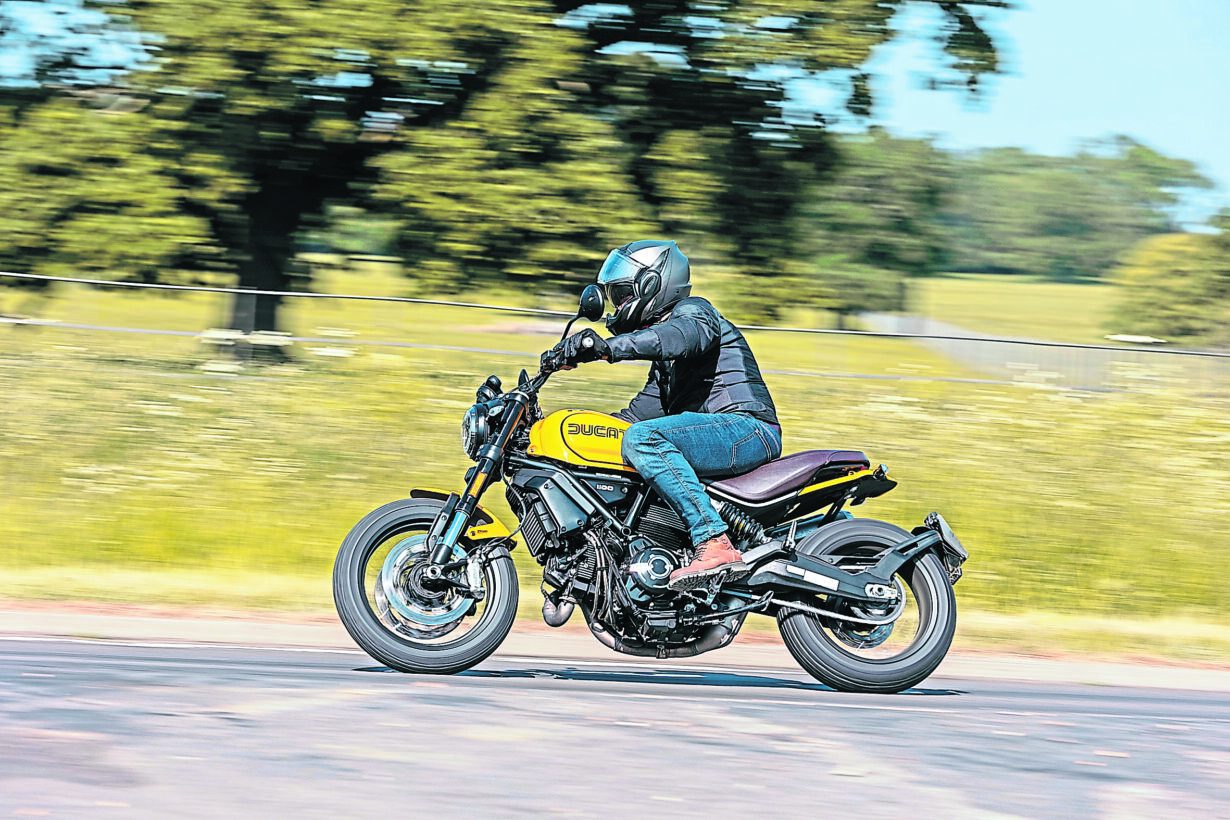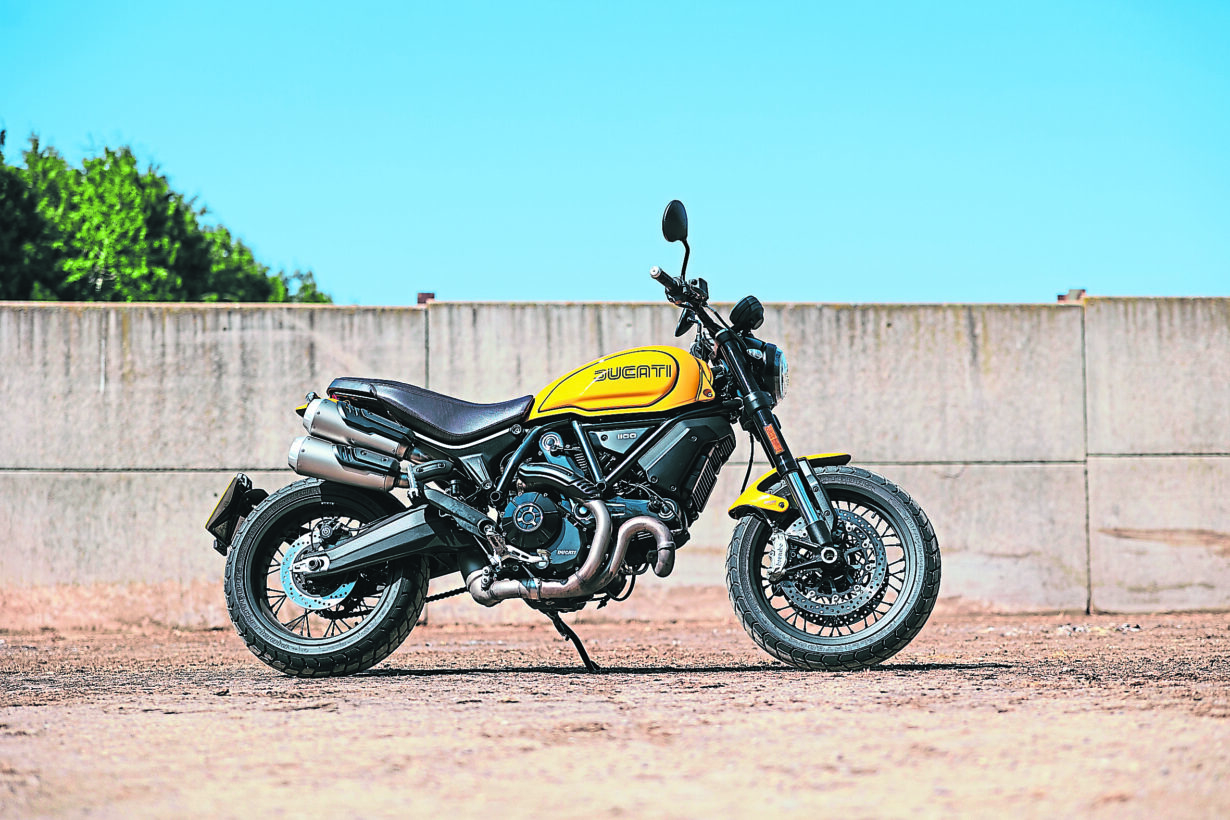Here’s Mikko Nieminen’s thoughts on the larger capacity Scrambler:
Like it or loathe it, it’s difficult to dismiss the Ducati Scramblers as nothing but trendy hipster bikes of the moment. I mean, yes, they may well be that, too, but their impact on Ducati and the industry as a whole has been massive.
Launched in 2015, the modern Ducati Scramblers were a revival of the company’s dual-sport singles made from 1962, hence the number 62 popping up so often on Scrambler bikes and apparel.

The bikes were an instant success, with the retro scene growing at least as fast as the sportsbike sales were dwindling, and to date Ducati has sold over 100,000 Scramblers. For a manufacturer of Ducati’s proportions, that’s decidedly unshabby.
The first generation of the revived Scramblers were mostly 800s, with just the learner-friendly 400cc Sixty2 tempting the A2 crowd. By 2018 Ducati had decided that more was more, and introduced three new 1079cc Scramblers: the 1100, the 1100 Special, and the 1100 Sport.
The bike we have here – the 1100 Tribute Pro – is a descendant of that larger-capacity line, and what separates it from the 800cc Scramblers is that it’s bigger in almost every way. It features the air-cooled 1079cc L-Twin with Desmodromic distribution, and two valves per cylinder, which gives you extra power and grunt over the smaller Scrambler, but is still far from being intimidating in any way. The Tribute Pro is also taller and heavier, with some slightly more higher spec components and a bigger 15-litre tank. In short, it’s exactly what you would expect from a bigger bike: slightly more capable and planted for higher speeds and longer runs, but not quite as nimble and easy to zip through slow city traffic. However, the difference is not as huge as you might think by just looking at the spec sheets, and the big Scrambler is a very versatile bike indeed.
Styling has always been the Ducati Scramblers’ strong suit, and the 1100 Tribute Pro is no exception. With the yellow colour scheme, brown seat, wire-spoked wheels and the classic logo on the tank, the inspiration for the look comes from the seventies, and bikes such as the 450 Desmo Mono and 750 Sport of 1972. And on a bike like this, it works.
Visually, the bike is almost spotless, bar the baffling decision to leave the end of the screw that holds the side panel of the tank visible, in the middle of the Ducati logo. Perhaps that’s what of-the-moment industrial design looks like, but to me it just smacks of a half-done job that was abandoned on a Friday afternoon, and forgotten by the time the tools were picked up again on a Monday morning.
Retro bikes often take a fairly simple approach to technology onboard, and the Tribute Pro follows the trend. One thing that gives the bike a modern feel is the rider aids. The ride-by-wire throttle enables three rider modes (Active, Journey and City) that help you get the best out of the bike in different environments, although the difference in ride feel is not huge.
Using the ride modes is easy as the switchgear is pretty simple and the menus easy to navigate. You can swap the modes on the go; just select the one you want, and close the throttle to activate the mode of your choice.
There’s traction control and cornering ABS to help keep you shiny side up. During the two days I rode the bike, I didn’t have any issues with either kicking into action too early, so it seems that they have been dialled in nicely to only assist when you need the helping hand.

The lights are LEDs, and the dash an LCD jobby, which to be fair looks like it could do with an update to the full-colour TFT item found on the new 800s. It’s not that it really lacks anything, but it looks a little dated next to the flashier TFT screens.
The beating heart of the big Scrambler is the air-cooled 1079cc L-Twin with Ducati’s trademark Desmodromic distribution, and two valves per cylinder. The power figures are a step up from the 800s, but not exactly outrageous. You get 84.5bhp and 88Nm of torque, which gives you the edge over the smaller models.
Unsurprisingly, the bigger engine gives you a smoother ride at high speeds, but feels a little lumpier than the 800 at very slow city riding speeds. There’s enough pull from the engine across the rev range to make it easy to ride, but you do get a better ride if you don’t let the revs drop right down.
The riding position is exactly what you’d expect from a Scrambler: relaxed and upright, with wide bars, a comfy flat seat, and a relaxed leg angle. The mirrors are pretty good, and all the switchgear buttons and sliders (the few that there are) are easy to use and feel sturdy. The throttle feel is nice and light, but not quite ‘computer game’ light, like ride-by-wire systems can be sometimes.
The brakes are not super-strong, but plenty good enough for the bike, and with two discs compared to the 800s’ single discs, they are well up to the job. The levers (both brake and clutch) are span adjustable, which makes the feel a little better, too. The suspension, similar to the brakes, is good but not amazing, although the units are adjustable, so someone with a better understanding of suspension set up might well be able to make them even better with a few clicks.
What all of this adds up to is a very pleasant motorcycle that can be ridden soft or hard, fast or slow, without anything negative really standing out from the experience.
There are motorcycles that can offer more in terms of power, refinement and handling, but the Tribute Pro makes up for any of those shortcomings with bags of character, and looks that are guaranteed to turn heads at bike meets.
At £12,795, the big Scrambler comes with a premium compared to Ducati’s 800cc Scramblers that start from £9995, but if you want something that’s just a little bit bigger physically, and handles speed and distance a little bit better, the Tribute soon justifies the price difference. And it comes with that stunning seventies styling, too. It’s definitely a bike that’s difficult not to fall for.
Support and gear supplied from Bikerheadz


